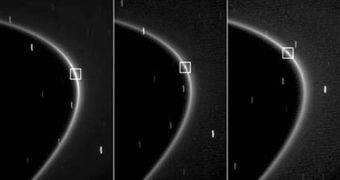The International Astronomical Union (IAU) announced on Tuesday that the international Cassini spacecraft had found another moon around Saturn, this one measuring a little over a third of a mile in width. The tiny body was orbiting the giant planet in between some of the dust rings, and was therefore impossible to notice until then. The G ring in particular is home to the new natural satellite, which has yet to be named. This find emphasizes again the importance that Cassini has in both studying the planet and some of its more interesting moons, such as Enceladus and Titan, which hold frozen water under the crust and methane lakes on top, respectively.
“Before Cassini, the G ring was the only dusty ring that was not clearly associated with a known moon, which made it odd. The discovery of this moonlet, together with other Cassini data, should help us make sense of this previously mysterious ring,” Cassini imaging team member astronomer Matthew Hedman, based at the Cornell University, shared. He made the statement in writing.
The discovery of the moon is not new. It was first identified on Cassini's telemetry pictures more than 6 months ago, but astronomers have thus far not yet been able to determine its exact size. Even now, that proves to be harder than the scientists first thought. They have managed to get the estimative reading by comparing it with another very small Saturnine moon called Pallene.
This comparison has yielded the approximate size measurements. The Cassini team says that it has been impossible for the spacecraft to take detailed measurements of the object because of its very small size. The new moon presents no large scientific importance for the study of the planet, but it helps explain some of the oddities that have so far characterized the gas giant, including the fact that the G ring has had no moon.
According to some theories, the rings around Saturn formed from icy debris that were expelled from the surface when a comet or meteor hit, or which failed to be drawn to it when the planet first formed. Regardless of how they were born, discoveries have thus far shown that all have been “endowed” with a moon. The G ring was different, and therefore required scientists to come up with a different theory, in order to explain the mystery. Now, it seems that it has been resolved.

 14 DAY TRIAL //
14 DAY TRIAL //